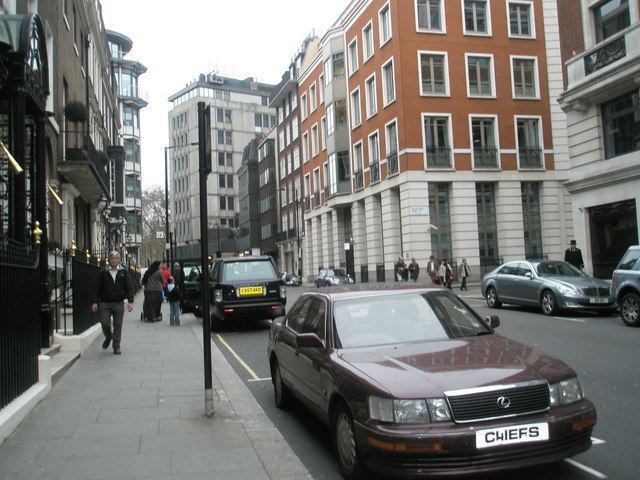Postal code W1J east end Fitzmaurice Place | Length 0.3 mi (0.5 km) west end A4202 road Major cities London | |
 | ||
Curzon Street is located within the exclusive Mayfair district of London. The street is located entirely within the W1J postcode district and is 400 yards to the north west of Green Park tube station. It is within the City of Westminster, running from Park Lane (past Shepherd Market) to Berkeley Square.
Contents
Map of Curzon St, Mayfair, London, UK
The street is thought to be named after George Howe, 3rd Viscount Howe; however, it was not until after his death that the title of Earl Howe was taken by someone with the last name Curzon. Before this time, it was called Mayfair Row.
History
Curzon Street has been home to various notable members of the peerage. In 1748, a house was built in Curzon Street for the 4th Earl of Chesterfield, called Chesterfield House. The house was demolished in 1937 and the site was redeveloped as an apartment block. Adjacent to Chesterfield House were smaller dwellings, which have served as the London residences for a number of members of the peerage, including Lord Hothfield, the Duke of Grafton, Lord Leconfield, Lady Blessington, Alfred de Rothschild, Lord Blythswood and the Earl of Inchcape. Also to the east was Wharncliffe House, rebuilt in 1750 and renamed for the Countess of Wharncliffe in the late 19th century. It is now part of the Saudi Arabian Embassy.
On the opposite side of the street, until 1894 stood Curzon Chapel, formerly Mayfair Chapel, first erected in 1730. Near to it was the smaller Keith's Chapel, the location before the Marriage Act 1753 of various clandestine marriages, including the marriages of the Duke of Chandos and Mrs Anne Jeffrey in 1744, Lord Strange and Mrs Lucy Smith in 1746, Lord Kensington and Rachel Hill in 1749, Sewellis Shirley and Margaret Rolle, widow of the second Earl of Orford in 1751, the Duke of Hamilton and Miss Gunning in 1752 and of Lord George Bentinck and Mary Davies in 1753.
Other inhabitants of Curzon Street have included the art collector Edward Solly (at no. 7, 1821–44), Benjamin Disraeli until his death in 1881, Lord Macartney until his death in 1806, Member of Parliament George Selwyn in 1776, Prince Pierre Soltykoff and Earl Percy.
In 1945 Leconfield House, at the corner of South Audley Street with an address on Curzon Street, became the home of the UK security service known as MI5 and remained so until 1976. Various activities were also conducted by MI5 at addresses on South Audley Street. In 1978 MI5 also occupied facilities at 1-4 Curzon Street known as "Curzon Street House" for use by the registry, administration and technical services departments; that site was redeveloped in 1996.
In Chesterfield Gardens, which is a cul-de-sac off Curzon Street during 1964; the second home office of the two offshore commercial stations known as Radio Caroline was established; and later that year at number 17 Curzon Street, the sales office of Radio London was opened, to be followed across the street at number 32 Curzon Street by establishment of offices serving Radio England and Britain Radio. The introduction of the UK Marine Offences Act which became law after midnight on 14 August 1967, forced the closure of all of these offices.
In the 1970s, American songwriter Harry Nilsson owned a two-bedroomed apartment (number 12) at 9 Curzon Street. Both Cass Elliot of The Mamas & the Papas and Keith Moon of The Who died in the flat within four years of each other, both aged 32.
Modern times
1 Curzon Street is a modern office building overlooking Berkeley Square. The fifth floor was home to AIG Financial Products, the division that "nearly destroyed" the US insurance company and which has been described by reporter Peter Koenig as the "epicenter" of the global financial crisis of 2008.
G. Heywood Hill Ltd, of The Bookshop at 10 Curzon Street: Letters between Nancy Mitford and Heywood Hill 1952–73, remains open for trading.
